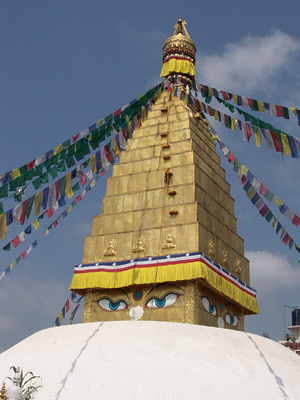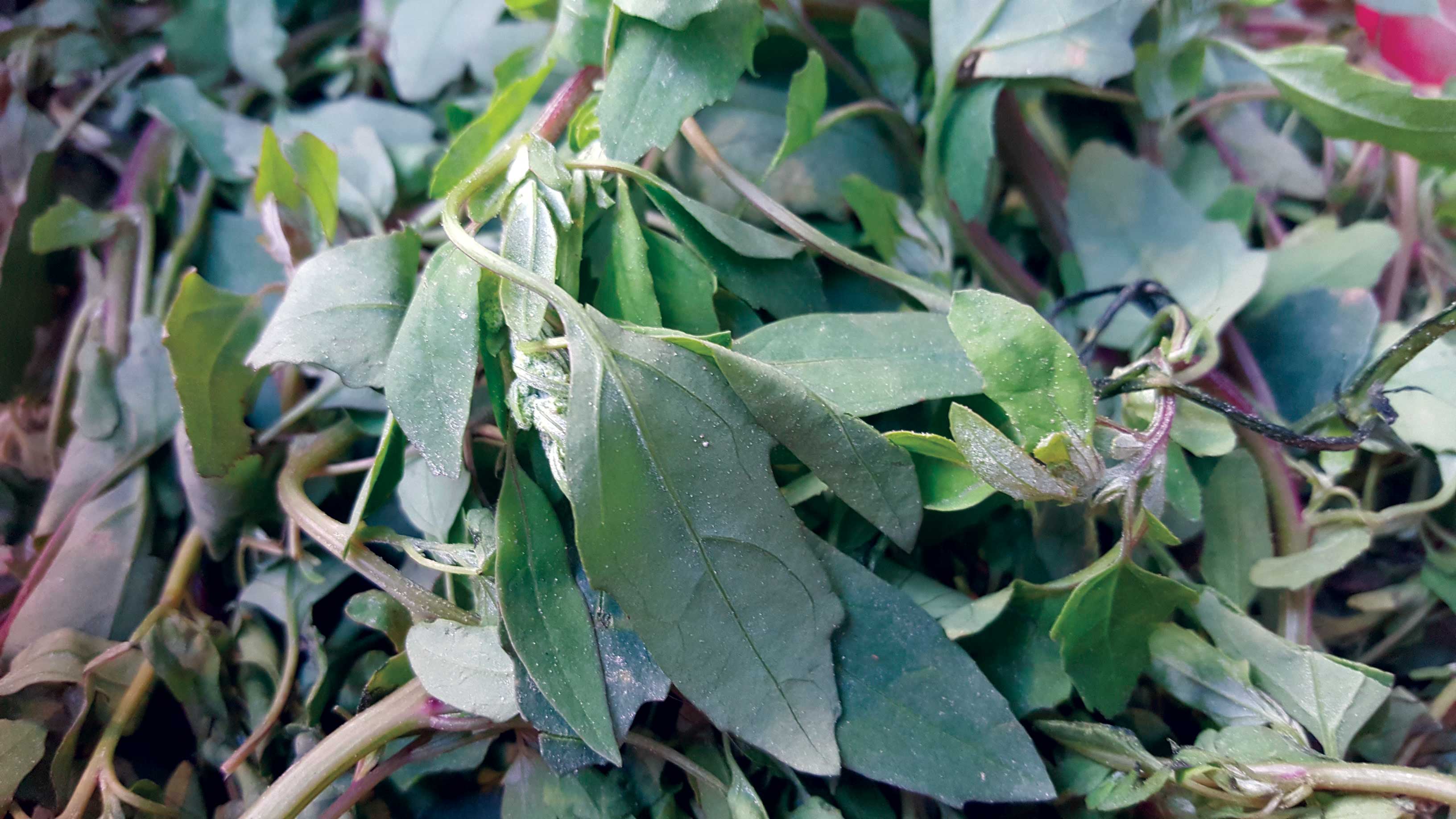As you travel past the Pashupatinath Temple and head towards Chahabil, a wonderful sight comes into view. A grand stupa lies on your left. Recently renovated, the chaitya has been transformed from a dull monument into a spectacular architectural beauty.
 Surrounded by yellow fences, it has a well designed main entrance. The white chaitya has a magnificent trayodashi on top. Four Buddhas adorn its four sides and many miniature stupas have been carved all around it along with some stone scriptures. Lungtas (prayer flags) in vibrant colors flow down from the top of the trayodashi. Manays (Buddhist prayer wheels) encircle the stupa and right below them you can light the oil lamps, which look marvelous in the evening time.
Surrounded by yellow fences, it has a well designed main entrance. The white chaitya has a magnificent trayodashi on top. Four Buddhas adorn its four sides and many miniature stupas have been carved all around it along with some stone scriptures. Lungtas (prayer flags) in vibrant colors flow down from the top of the trayodashi. Manays (Buddhist prayer wheels) encircle the stupa and right below them you can light the oil lamps, which look marvelous in the evening time.
For those interested in whiling away their time, the benches and stone seating would be the ideal place to relax and bask in the splendor of this stupa. The bells chiming along with the wind give off a pleasant sound. Towards the left is a special statue of Amitava Buddha. Beside the main stupa, many other smaller stupas adorn this site. As it is visible from the busy roadside in Chabahil, locating it is not a problem. A taxi ride from the heart of the city (New Road) to the stupa takes only about 20 minutes provided there are no traffic jams on the way. The gates open at 5:00 a.m. and close at 9:00 p.m.
Though popularly known as the Chabahil stupa or the Dhan Dhoj stupa, after many years of speculation regarding the origin of this stupa, it is now credited to Charumati, the youngest daughter of King Ashoka. It is believed that on her father’s advice, she came to the Kathmandu valley to spread the teachings of the Buddha. She is said to have married here. Some are of the opinion that she married King Devpala after whom the area was named Dev Patan. But Prakash Darnal, an archaeologist/officer at the Department of Archaeology says, “This is yet to be confirmed.”
The renovation was supervised by the Department of Archaeology as renovation of any heritage site which is more than a 100 years old, has to be authorized by the Department. Prakash Darnal and other members saw to it that the stupa was restored maintaining the original design as far as possible.
Charumati’s father, King Ashoka of India was a very ambitious ruler and led his army to many victories. But he was not satisfied with his achievements and always yearned for more. One day he set his eyes on a young monk roaming through his land and heard him preach. His preaching inspired the great king. During his reign, he had killed a great number of people, but realizing his mistakes he repented and wished to change his way of life. Motivated to do something different, he decided to give up fighting and walk the path of peace. Subsequently, he became a Buddhist and ventured to distant lands enlightening people about Buddhism. He came to visit Lumbini, the birth place of Lord Buddha, and there he made the famous Ashoka stambha. He is believed to have also built around 84,000 stupas in Nepal and India.
Fascinating facts came to light during the renovation of the Charumati stupa. A stone sculpture containing the details of its history was recovered. Another sculpture that is said to be older than the stone sculpture at Changu Narayan, was also uncovered and is believed to be the oldest found in the valley. It is believed to be almost 2,300 years old and has the Brahmi script inscribed on it
Here in Charumati Mission Vihar, observing some of the precious objects unearthed during the renovation was a delight. A stupa with a crystal on top was one of the first relics discovered. Other remarkable objects such as gold, silver and metal coins belonging to the Kirati, Licchavi, Malla and Shah period, were also discovered during the digging. Numerous statues and stupas made of metal were also recovered. In the past, there were many disputes regarding the identity of the builder. Due to the presence of the trayodashi above the stupa, Dharma Dev is said to have built it, since such structures were not found in the Ashoka period. It was also referred to as the Dhan Dhoj Chaitya after him. But now with more evidence gathered, it seems that Dharma Dev had only placed this additional structure on the stupa.
A fact that will surprise many is that this stupa is even older than the famous Bouddhanath. The other Charumati stupa in Patan is also said to have been built during the same time. This was the fourth renovation after nearly 250 years. Girwan Juddha Shah is said to be the first to renovate it. During the Malla period, it was restored twice. The recent renovation was carried out by Shree Dhan Dhoj Chaitya Renovation Committee and its members include Narattam Baidya, who worked as the Chairman, Wangchu Sherpa as Treasurer and Rev. Tapassi Dhamma as Co-Treasurer.
Rev. Tapassi Dhamma, now resides in the Charumati Mission Vihar of which, he is the founder. This vihar is situated near the stupa and he has been caretaker for the last eleven years. It was his relentless efforts that made the recent renovation possible. While studying in Sri Lanka, Ven. K. Dhamma Vasa Mahathero, one of the chief monks advised him to return to Nepal to work in the Charumati Stupa, which is incidentally, very popular among the monks in Sri Lanka as well as other parts of the world. He was dismayed to see the pathetic condition of the stupa, which is otherwise revered in other countries. The stupa’s compound was nothing more than a parking lot, filled with garbage and people were seen using it as a public toilet. Not deterred by its condition, he sought help from the locals and cleared up the mess, enhancing the surroundings. He went on to build a surrounding wall, which now shields it from the busy road. The building costs came to NRs 7,00,000, which was raised through donations from various people. But, problems there were many. The walls of the Chaitya were cracking and the wooden structure, which held it in place, was also crumbling. With its close proximity to the road, it is believed the vibrations caused by heavy traffic may be the reason for the increase in these cracks. The renovation had to take place soon, as the stupa was on the verge of collapse.
With the formation of a committee and funds donated by people from all walks of life, renovation commenced from 17th November, 2002. After months of laborious work and rituals, the renovation was finally completed on 13th June, 2003. The total funds raised reached the respectable figure of NRs 90,00,000. A Rinpoche from Ladakh donated about NRs 18,00,000 and 3 kg of gold, while another contributor named Nima Lama donated NRs.5,25,000. The Renovation Committee raised another NRs.35,000 and the rest of the money came as donations by various people.
The complete transformation of the stupa resulted in the newly placed grand trayodashi above the restored chaitya. The inner wooden structure which holds the trayodashi in place, also known as Yashinha, was crumbling and has been replaced with a new one which measures 51 feet and weighs 3 kilos costing around NRs.1,52,000. Special mantras were inscribed on it in Brahmi and Bhujimol scripts following the rules of this religious activity. They were brought from Gwarko, Kausaltar. When the former Yashinha was removed, a wooden cover was found underneath it, and lying below it were many smaller stupas plated in gold and silver. A metal piece with a description of the items present was also excavated. Miniature stupas were kept in all four corners as well. To the valuables recovered from the stupa, several new ones were added, such as coins of King Birendra and King Gyanendra, new stupas, a foot high chaitya from Sri Lanka and Aasti Dhatu (a relic of the Buddha) brought from Burma.
Some of the significant objects discovered here, have been taken to the Department of Archaeology for further study and their preservation. In all, nearly 385 miniature stupas and 100 statues were found. A stone slab from the Licchavi era and another that has the Brahmi script inscribed on it, were some of the valuable relics taken for research. Some of the coins discovered were Kusankalean i.e. belonging to the 1st century.
Presently, Tri Ratna Shakya performs the daily rituals in this chaitya, which has been a family tradition for many decades. During Purnima and other major festivals, special programs are organized here. A watchman keeps an eye on the premises. But proper maintenance of this place is certainly deficient. Unfortunately, not much is being done to promote the chaitya, which was restored with so much difficulty and now looks resplendent amidst the chaos of Chabahil.
Ukesh Bhuju, President of Nepal Heritage Society, says, “The Charumati stupa is important as it has its own history. To promote it during renovation we organized a reporters meeting highlighting it.” They had also taken the help of experts to ensure proper renovation. “As it holds a part of Nepali history,” he added, “It cannot be compared with other monuments as each stupa holds its own importance”. He encourages others to engage in such work either by themselves or with the help of the government to preserve other historical sites.
A committee may soon be formed for the maintenance and preservation of this masterpiece. Though there has been a slight increase in the number of visitors both Nepali and foreigners after the renovation, due to inadequate publicity, the number is still quite low. With time it will surely gain popularity and its true worth appreciated. My visit to the stupa was a beautiful experience. You could make it too. ?
Some lesser-known vegetable dishes from the southern plains
I’m not a vegetarian but I love vegetables. And whenever I get to the southern plains of Nepal, I try...









